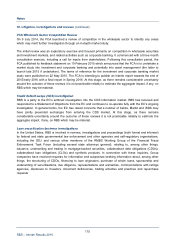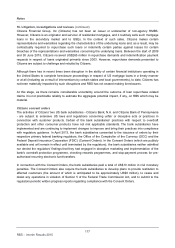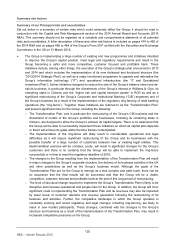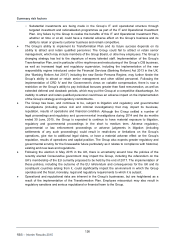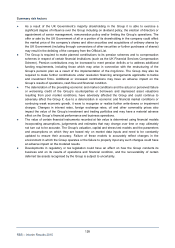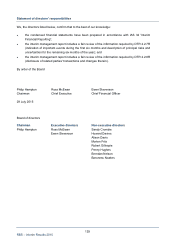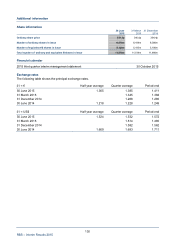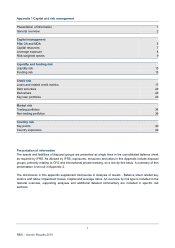RBS 2014 Annual Report Download - page 127
Download and view the complete annual report
Please find page 127 of the 2014 RBS annual report below. You can navigate through the pages in the report by either clicking on the pages listed below, or by using the keyword search tool below to find specific information within the annual report.
125
RBS – Interim Results 2015
Summary risk factors
Summary of our Principal risks and uncertainties
Set out below is a summary of certain risks which could adversely affect the Group; it should be read in
conjunction with the Capital and Risk Management section of the 2014 Annual Report and Accounts (2014
R&A). This summary should not be regarded as a complete and comprehensive statement of all potential
risks and uncertainties. A fuller description of these and other risk factors is included on pages 474 to 492 of
the 2014 R&A and on pages 466 to 484 of the Group’s Form 20-F as filed with the Securities and Exchange
Commission in the US on 31 March 2015.
● The Group is implementing a large number of existing and new programmes and initiatives intended
to improve the Group’s capital position, meet legal and regulatory requirements and result in the
Group becoming a safer and more competitive, customer focused and profitable bank. These
initiatives include, among other things, the execution of the Group’s strategic plan announced in 2013
and 2014 and which includes the implementation of its new divisional and functional structure (the
“2013/2014 Strategic Plan”) as well as a major investment programme to upgrade and rationalise the
Group’s information technology (“IT”) and operational infrastructure (the “IT and Operational
Investment Plan”), further initiatives designed to reduce the size of the Group’s balance sheet and de-
risk its business, in particular through the divestments of the Group’s interest in Williams & Glyn, its
remaining stake in Citizens and the “higher risk and capital intensive assets” in RCR as well as a
significant restructuring of the Group’s Corporate and Institutional Banking (“CIB”) segments and o
f
the Group’s business as a result of the implementation of the regulatory ring-fencing of retail banking
operations (the “ring-fence”). Together, these initiatives are referred to as the “Transformation Plan”
and present significant risks for the Group, including the following:
○ The Transformation Plan, and in particular the restructuring of the Group’s CIB business and the
divestment of certain of the Group’s portfolios and businesses, including its remaining stake in
Citizens, are designed to allow the Group to achieve its capital targets. There is no assurance that
the Group will be able to successfully implement these initiatives on which its capital plan depends
or that it will achieve its goals within the time frames contemplated;
○ The implementation of the ring-fence will likely result in considerable operational and legal
difficulties as it will require significant restructuring of the Group and its businesses with the
possible transfer of a large number of customers between new or existing legal entities. This
implementation exercise will be complex, costly, will result in significant changes for the Group’s
customers and there is no certainty that the Group will be able to implement the ring-fence
successfully or in time to meet the regulatory deadline of 2019;
○ The changes to the Group resulting from the implementation of the Transformation Plan will result
in major changes to the Group’s corporate structure, the delivery of its business activities in the U
K
and other jurisdictions as well as the Group’s business model. Although the goals of the
Transformation Plan are for the Group to emerge as a less complex and safer bank, there can be
no assurance that the final results will be successful and that the Group will be a viable,
competitive, customer focused and profitable bank at the end of this long period of restructuring;
○ The level of structural change required to implement the Group’s Transformation Plan is likely to be
disruptive and increase operational and people risks for the Group. In addition, the Group will incu
r
significant costs in implementing the Transformation Plan and its revenues may also be impacted
by lower levels of customer retention and revenue generation following the restructuring of its
business and activities. Further, the competitive landscape in which the Group operates is
constantly evolving and recent regulatory and legal changes, including ring-fencing, are likely to
result in new market participants. These changes, combined with the changes to the Group’s
structure and business as a result of the implementation of the Transformation Plan, may result in
increased competitive pressures on the Group;


